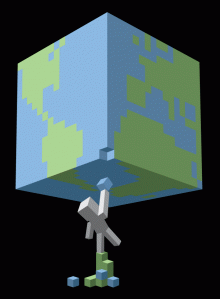Few dispute that games mirror reality and that reality often resembles games. But the game of Minecraft takes this to new levels. And this is driving innovation. Here’s why:
Since its release seven years ago, Minecraft has become a global sensation, captivating a generation of children. There are over 100 million registered players, and it’s now the third-best-selling video game in history, after Tetris and Wii Sports. In 2014, Microsoft bought Minecraft — and Mojang, the Swedish game studio behind it — for $2.5 billion.
There have been blockbuster games before, of course. But as Jordan’s experience suggests — and as parents peering over their children’s shoulders sense — Minecraft is a different sort of
For one thing, it doesn’t really feel like a game. It’s more like a destination, a technical tool, a cultural scene, or all three put together: a place where kids engineer complex machines, shoot videos of their escapades that they post on YouTube, make art and set up servers, online versions of the game where they can hang out with friends. It’s a world of trial and error and constant discovery, stuffed with byzantine secrets, obscure text commands and hidden recipes. And it runs completely counter to most modern computing trends. Where companies like Apple and Microsoft and Google want our computers to be easy to manipulate — designing point-and-click interfaces under the assumption that it’s best to conceal from the average user how the computer works — Minecraft encourages kids to get under the hood, break things, fix them and turn mooshrooms into random-number generators. It invites them to tinker.
In this way, Minecraft culture is a throwback to the heady early days of the digital age. In the late ’70s and ’80s, the arrival of personal computers like the Commodore 64 gave rise to the first generation of kids fluent in computation. They learned to program in Basic, to write software that they swapped excitedly with their peers. It was a playful renaissance that eerily parallels the embrace of Minecraft by today’s youth. As Ian Bogost, a game designer and professor of media studies at Georgia Tech, puts it, Minecraft may well be this generation’s personal computer.


